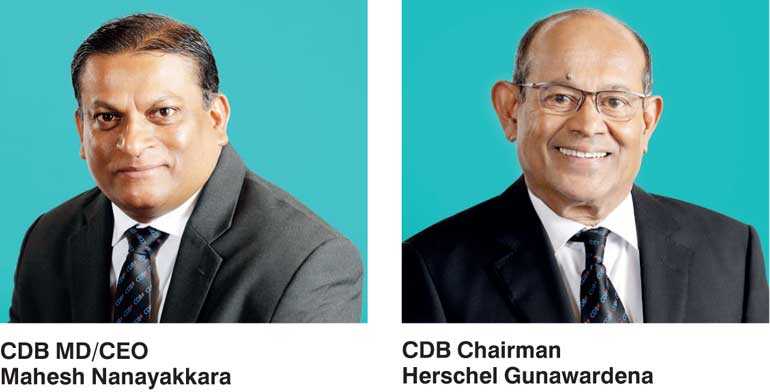Wednesday Apr 02, 2025
Wednesday Apr 02, 2025
Monday, 25 June 2018 00:00 - - {{hitsCtrl.values.hits}}

The multi-award-winning Citizens Development Business Finance PLC (CDB), which has continuously sustained impressive financial performance year-on-year, recorded yet another spectacular 2017/18 milestone with its after tax profit blazing ahead to a remarkable 39% increase to Rs. 1.4 b, from last two year’s back-to-back record of topping the Rs. 1 b mark.
CDB’s aggressive bottom line growth in 2017/18 was driven by a 37% surge in its top line, an upward trajectory to Rs. 11.8 b, from Rs. 8.6 b in 2016/17. These revenue gains resulted in a 20% increase in net interest income, to Rs. 3.5 b, from Rs. 2.9 b in the previous year. This is on the back of a remarkable lending portfolio growth of 38%.
Demonstrating the quality of portfolio management, credit growth has been achieved while simultaneously controlling the non-performing credit risk. The company closed the year by containing the Gross NPL ratio (Net of IIS) to 3.07%, from 3.08% in the previous financial year, and the Net NPL ratio (Net of IIS and provisions) slashed to 0.89%, from 1.05%.
The company sustained a 30% growth in net operating income, which reached Rs. 4.8 b, from Rs. 3.7 b, with the operating profit margin continuing to improve from 16.27% to 16.63%. The profit before tax also moved up by 37% to Rs. 1.7 b. Despite the rising cost structures experienced during 2017, CDB has successfully reduced its cost to income ratio from 58.28% one year ago, to 54.52%, indicating the efficiency gains that have accrued during the year.
CDB closed the year by recording a stronger financial base, with total assets beefed up by 40% to Rs. 75.5 b on the back of robust loan portfolio growth to Rs. 59.4 b, from Rs. 43.2 b, up 38%. Total equity increased by 15%, to Rs. 7.2 b and the company also grew its deposit base to Rs. 44.7 b, which is a growth of 37% year-on-year. Return on average assets improved to 2.17% from 1.93%.
CDB has proposed a first and final dividend of Rs. 5 per share, in comparison to last year’s dividend of Rs. 3.50 per share, subject to approval of shareholders at the Annual General Meeting.
The earnings per share has moved up to Rs. 25.80 from Rs. 18.53, whilst the Return on Equity (after tax) has increased to 20.92% from 17.83% and Net Asset Value per share has augmented to Rs. 131.71, from Rs. 114.93.
While expanding its business activities, the company has remained above and beyond all regulatory capital adequacy directives, to ensure the financial stability of the company at all times. The Core Capital (Tier I) was maintained at 10.64%, compared to the minimum requirement of 5%, Total Capital (Tier II) recorded at 13.93%, which is also above the minimum requirement of 10% and the Statutory Liquidity Ratio recorded at 14.37% against the regulatory requirement of 10%.
Demonstrating the proactive approach to good governance which is a hallmark of the Company, CDB has also been an early adopter of the SLFRS 9 – Financial Instruments, which has replaced the LKAS 39 – Financial Instruments: Recognition and Measurement.
The audited financial statements released to the Colombo Stock Exchange, have been prepared to reflect the impact of this transition to SLFRS 9, from LKAS 39. As per the transition provisions of SLFRS 9, CDB has adjusted this transition impact through opening net assets as at the date of transition, which is 1 April 2017.
CDB’s 90.38% owned specialised leasing subsidiary UCL has performed well during the year under review, growing its balance sheet to Rs. 1.7 b from Rs. 693 m. The after-tax profit recorded a figure of Rs. 55 m in comparison to the previous year’s figure of Rs. 22 m, contributing towards a consolidated after-tax profit of Rs. 1.45 b at group level, reflecting a growth of 42%. UCL has strongly augmented its position within the group strategy and is well poised to accelerate its progress.
With its growth strategy gaining momentum and the CDB brand presence permeating the island in all directions, CDB has adopted a focus strategy, covering both disruptive and sustained initiatives embedded under an emergent and deliberate strategic framework, embarking on a discovery driven journey – that from being a disruptor to an incumbent company within the financial intermediary business.
Discover Kapruka, the leading online shopping platform in Sri Lanka, where you can conveniently send Gifts and Flowers to your loved ones for any event including Valentine ’s Day. Explore a wide range of popular Shopping Categories on Kapruka, including Toys, Groceries, Electronics, Birthday Cakes, Fruits, Chocolates, Flower Bouquets, Clothing, Watches, Lingerie, Gift Sets and Jewellery. Also if you’re interested in selling with Kapruka, Partner Central by Kapruka is the best solution to start with. Moreover, through Kapruka Global Shop, you can also enjoy the convenience of purchasing products from renowned platforms like Amazon and eBay and have them delivered to Sri Lanka.
Discover Kapruka, the leading online shopping platform in Sri Lanka, where you can conveniently send Gifts and Flowers to your loved ones for any event including Valentine ’s Day. Explore a wide range of popular Shopping Categories on Kapruka, including Toys, Groceries, Electronics, Birthday Cakes, Fruits, Chocolates, Flower Bouquets, Clothing, Watches, Lingerie, Gift Sets and Jewellery. Also if you’re interested in selling with Kapruka, Partner Central by Kapruka is the best solution to start with. Moreover, through Kapruka Global Shop, you can also enjoy the convenience of purchasing products from renowned platforms like Amazon and eBay and have them delivered to Sri Lanka.